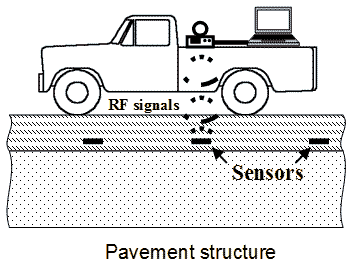U.S. Department of Transportation
Federal Highway Administration
1200 New Jersey Avenue, SE
Washington, DC 20590
202-366-4000
Federal Highway Administration Research and Technology
Coordinating, Developing, and Delivering Highway Transportation Innovations
| REPORT |
| This report is an archived publication and may contain dated technical, contact, and link information |
|
| Publication Number: FHWA-HRT-12-072 Date: May 2013 |
Publication Number: FHWA-HRT-12-072 Date: May 2013 |
This report describes the efforts undertaken to develop a novel self-powered strain sensor for continuous structural health monitoring of pavement systems, which was conducted under the Federal Highway Administration (FHWA).
State highway agencies (SHAs) typically spend several million dollars per year to monitor the condition of pavement structures as part of developing their Pavement Management System (PMS) databases. Two approaches are typically taken: (1) conducting manual distress surveys or (2) conducting automated condition surveys using specially equipped vehicles. However, these monitoring approaches are reactive instead of proactive in terms of detecting damage since they merely record the distresses that have already appeared. In addition, for thicker pavements, surface cracks may not be indicative of structural damage if they exhibit top-down cracking. The true pavement structural condition and rate of deterioration are needed to plan optimal structural rehabilitation activities and future budget needs. Therefore, with effective pavement preservation activities that intervene early to preserve and extend the life of pavements, surface cracks cannot be used as a reliable indicator of structural condition or health of the pavement structure.
Another approach used to monitor the structural health of the pavement network is deflection testing. The most popular method is using a falling weight deflectometer (FWD), although it has been largely implemented for project-level evaluations as opposed to network-level evaluations mainly because of significant personnel time and costs as well as safety concerns. The latest development of the traffic speed deflectometer (TSD) technology promises to address some of these concerns. However, the current technology is only capable of measuring peak deflection, which is not suitable for predicting remaining fatigue life. Furthermore, TSDs can only be used cost effectively on a periodic basis (e.g., annually or bi-annually). As a result, there is a continuing need for low-cost technologies that facilitate early damage detection and future condition evaluation for pavement network management.
Currently, pavement instrumentation for condition monitoring is done on a localized and short-term basis, mainly for research purposes. The currently used technology does not allow for continuous long-term monitoring because of the limitations caused by the use of batteries (i.e., it is impractical to replace batteries for embedded sensors). Also, the deployment of existing systems on a network level remain unfeasible due to cost, unease of installation and data collection techniques (need for fixed and rather massive data acquisition systems), and low durability (due to required wiring).
Although recently there has been significant research performed on distributed wireless sensors for monitoring industrial process parameters and environmental conditions, all of the commercially viable sensors developed to date require either solar or battery power. It is unlikely that such powering means would be practical for monitoring pavement structures because periodic replacement of batteries or the expense of solar power technology would be cost prohibitive and in some cases impractical (e.g., due to safety on highly trafficked or inaccessible roads). It is believed that energy harvesting could constitute a viable alternative. Energy harvesting (often referred to as "energy scavenging") is the process of converting ambient energy (i.e., the kinetic energy from structural vibration or mechanical strain) into electrical energy that can be used to power the sensor.
This research focused on designing and testing a sensor system for pavement monitoring. The system consists of a novel self-powered wireless sensor capable of detecting damage and loading history for pavement structures. The developed system is based on the integration of a piezoelectric transducer with an array of ultra-low power floating gate (FG) computational circuits. A miniaturized sensor was developed and tested. It was shown that it is capable of continuous battery-less monitoring of strain events integrated over the occurrence duration time.
Successful development of the proposed strain sensor could dramatically transform the economics of pavement preservation/management and ultimately improve the serviceability of pavements. The developed system consists of a network of low-cost sensors distributed along the pavement. Each sensor node is self-powered and capable of continuously monitoring and storing the dynamic strain levels in the host pavement structure. The strain data are stored onboard the sensor, which consists of the self-powered sensor strip and the small scale electronics. The data from all the sensors are periodically uploaded wirelessly to a central database. The sensor is read through standard radio frequency (RF) transmission using a RF reader that is either manually operated or mounted on a moving vehicle. By directly outfitting service vehicles with low-cost RF transponders, the roads can be frequently monitored to detect changes in structural integrity that may not only foreshadow a future crack/distress manifestation but also allow for more accurate scheduling of preservation actions. It should be noted that only a single RF reader is needed to inspect the sensor network. Given the annual costs of infrastructure inspection, this sensor cost could rapidly pay for itself. Figure 1 shows a schematic of the envisioned system.

Figure 1. Illustration. Array of self-powered sensors capable of monitoring cumulative strain history of the host pavement structure.
The objectives of the project are as follows:
The remaining chapters of this report are organized as follows: